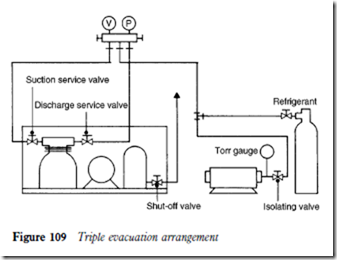Evacuation
It is imperative, with halogen refrigeration systems, that all traces of air, non-condensibles and moisture be removed. If this is not achieved then the presence of air or nonondensibles will cause abnormally high discharge pressures and increased temperatures, resulting in the conditions relating to high operating pressures previously explained.
Air in the system will also mean that a certain amount of moisture contained in the air will be circulated with the refrigerant under operating conditions. This moisture could freeze at the orifice of an expansion valve or liquid capil- lary to prevent refrigerant flow to the evaporator, should the filter drier become saturated.
When a system has been pressure leak tested, traces of nitrogen may also be present to further aggravate the high discharge pressure condition.
There are two ways in which a system can be evacuated, the deep vacuum method and the dilution method.
Deep vacuum method
To meet the requirements of a contaminant-free system, a good vacuum pump is necessary. Under normal ambient temperatures a vacuum of 2 torr should be achieved with a single deep-vacuum cycle.
The length of a deep-vacuum cycle can vary considerably: the larger the installation, the longer the cycle. This may be left to the discretion of the commissioning engineer, as stipulated by company policy, or a specific period may be requested by the customer. Obviously a large high vacuum pump will expedite the procedure. It is not unusual for a system to be left on vacuum for 24 or 48 hours, or even for several days, to ensure that it is completely free from contaminants.
The advantages of a deep vacuum are that (a) there will not be any appreciable loss of refrigerant other than the final trace charge administered while leak testing, and (b) it is possible to reclaim a trace charge of refrigerant from a large system (see Chapter 16 relating to contaminants and refrigerant recovery). Also, the immediate environment will not be polluted by refrigerant vapour so that it is difficult to carry out a final leak test when the system is charged. This will be evident when comparison is made with the dilution method.
D lut on method
The dilution method or triple evacuation should be carried out using OFN (oxygen free nitrogen) and not with a trace charge.
1 The initial nitrogen charge should be left in the system for at least 15 to 30 minutes. It can then be re-evacuated to a vacuum of 5 Torr.
2 This vacuum is then broken with another OFN charge allowing time for it to circulate the system.
3 Re-evacuate and charge the system with refrigerant.
This repetition may appear to be unnecessary but after a single or double evacuation small pockets of non-condensables may still be entrained in the system pipework or controls. By repeatedly breaking the vacuum with OFN these pockets will be dispersed or diluted by the OFN.
After each evacuation the pump should be switched off and, after a few minutes settling period, a vacuum reading taken. The system should then be left for another 30 minutes and another reading taken. A rise in pressure means that there is still a certain amount of moisture present.
Under no circumstances should the system compressor be used for the evacuation of the system.
A comparison of vacuum gauge graduations is given in Figure 107. Note that 1 torr D 1 mm Hg D 1000 p,m Hg and micrometres are referred to as microns.
Figure 108 shows a typical arrangement for connecting a vacuum pump for deep evacuation.
During the evacuation of the system the evaporator fan(s) may be oper- ated and defrost systems switched to the heating cycle in order to raise the temperature in the evaporator. Heaters must not remain energized for excessive periods in case of overheating of the evaporator and possible damage. It
is also very important to ensure that no parts of the system are isolated from the vacuum pump.
Figure 109 shows a triple evacuation arrangement. When the pump is operating, the isolator valve must be open, the service valves on the compressor in the midway position, the liquid shut-off valve at the receiver open, and the refrigerant cylinder valve closed. Both valves on the gauge manifold must
be open. When breaking the vacuum with refrigerant vapour pressure, ensure that the pump isolating valve is closed.
Table 7 shows the pressure/temperature relationship for water. When evacuating a system, remember that there must be an adequate temperature difference between the ambient temperature and that of the water to provide the heat necessary to vaporize the water.

